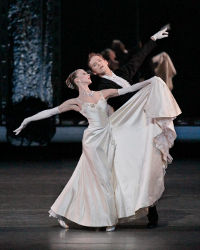Laura Jacobs at The New Criterion:
 The map of Balanchine’s life once he left Russia in 1924 and until he finally settled into the New York City Ballet in 1948 may read as a kind of wandering, but his life as an artist was made of circles: the revolving of the repertory, the return to old ballets, the rethinking and recalibration of steps and phrases. To the dismay of his audience, for instance, Balanchine pared back the iconic Apollon musagète, his breakthrough of 1928. Again and again he rechoreographed Stravinsky’s Le Baiser de la fée (based on heartbroken melodies by Tchaikovsky), trying to find the right form for its story of a child kissed into art and thus frozen out of a normal life—his story. And despite the astonishing breadth of his repertory, it was dominated by what one might call the waltz step of desire–love–loss. In fact, this was a vortex Balanchine needed. The centrifugal pull of the waltz, its three-four time as self-generating as the tide, rolling and turning, drawing one in and under, was pure energy.
The map of Balanchine’s life once he left Russia in 1924 and until he finally settled into the New York City Ballet in 1948 may read as a kind of wandering, but his life as an artist was made of circles: the revolving of the repertory, the return to old ballets, the rethinking and recalibration of steps and phrases. To the dismay of his audience, for instance, Balanchine pared back the iconic Apollon musagète, his breakthrough of 1928. Again and again he rechoreographed Stravinsky’s Le Baiser de la fée (based on heartbroken melodies by Tchaikovsky), trying to find the right form for its story of a child kissed into art and thus frozen out of a normal life—his story. And despite the astonishing breadth of his repertory, it was dominated by what one might call the waltz step of desire–love–loss. In fact, this was a vortex Balanchine needed. The centrifugal pull of the waltz, its three-four time as self-generating as the tide, rolling and turning, drawing one in and under, was pure energy.
more here.
